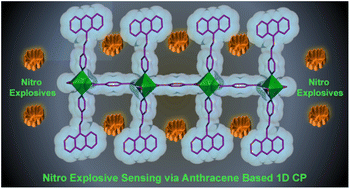Facile construction of an anthracene-decorated highly luminescent coordination polymer for the selective detection of explosive nitroaromatics and the mutagenic pollutant TNP†
Abstract
Explosive nitroaromatic compounds (epNACs) are a group of chemicals that have caused significant human casualties through terrorist attacks and they also pose health risks. For the benefit of homeland security and environmental health, there is room for advancing research on the precise detection of epNACs. Coordination polymers (CPs) successfully serve this purpose because of their binding abilities and quenching capabilities. In this regard, a one-dimensional (1D) CP [Zn(bdc)(avp)2(H2O)]n (1; H2bdc = 1,4-benzenedicarboxylic acid and avp = 4-[2-(9-anthryl)vinyl]pyridine) was synthesized, which remarkably demonstrated extremely efficient ratiometric and selective sensing capacity toward epNACs and the mutagenic pollutant 2,4,6-trinitrophenol (TNP) with a quick response. Density functional theory (DFT) calculations provided a thorough analysis of the mechanistic routes behind the quenching reaction. Herein, geometrically accessible interaction sites were strategically decorated using anthracene moieties, allowing the quick and precise detection of explosive nitro derivatives and the carcinogenic pollutant TNP with increased sensitivity.



 Please wait while we load your content...
Please wait while we load your content...